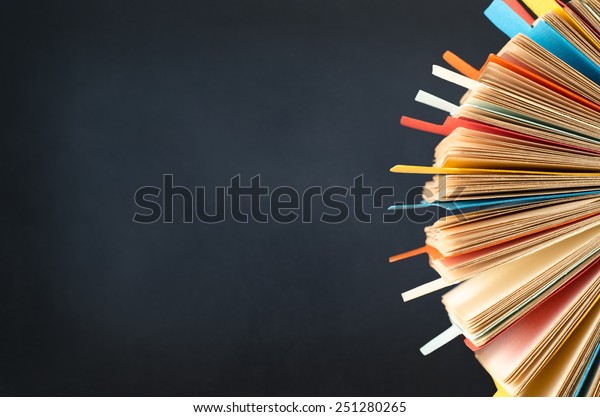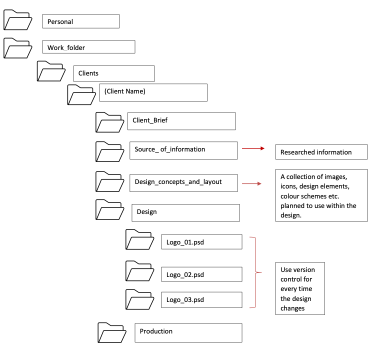Welcome to Collect Information on Design History and Theory. As you progress through this topic, you will learn about:
- Sources of information on design history and theory
- Organise research material and findings.
Terminology and vocabulary reference guide
Working in an office environment, you need to be familiar with terms associated with principles and use the terms correctly (and confidently) with clients, your colleagues, and other industry professionals. You will be introduced to many terms and definitions. It can come handy to start a vocabulary reference guide by adding any unfamiliar terms into a notebook or a Word document.
Activities
There are activities within this topic and an automated quiz at the end of this topic. This is not part of your assessment but will provide practical experience to help you in your work and help you prepare for your formal assessment.
b. Research is one method used to obtain knowledge in order to gain a good understanding and inspiration that will help in the development of a design. There are a variety of sources that can be used when researching that provide useful and valid information.
Researching design history and theories may be required throughout the design process for a project or design brief. Many may wonder why knowing the design history and theory would apply to today’s current design work. Truth be told, though it will not always be needed for every project, it is important to understand the relationship that the design history and theory has with the present work and how this information can be applied to a current design. Let’s find out more about the research process and the importance of gaining sources of information on the history and theory of design to produce a final product.
The research process

The research process commences soon after a brief is received and will generally consist of four (4) basic steps:
- Define the historical design theory
Upon receiving a brief, it is important to accurately interpret what are the needs of the design. This will clarify the historical design theory that will need to be researched. - Collecting information on historical design theories
The information must be gathered when researching the historical design theories applicable to the needs of the project. The information gathered will derive from a variety of sources. These sources must prove to be valid for the project. For instance, a source needs to be authentic, logical and contain reasonable information that will be useful in the planning of the design, helping to gain ideas and inspirations that will satisfy the needs of the brief. Be mindful that the sources may lose validity if they are not credible or reliable. - Evaluate the information
One form of evaluating the information from the acquired sources is to discuss them with others, see if they are a reliable source for the design brief that is needed. Have the sources assisted in gaining useful design ideas, concepts and styles for the design work? For instance, if the design brief requires information from a specific historical design theory to help inform the work, the current trends found in one source may not be applicable if it is not accurately reflecting the design style of the specific period. Therefore, making the sources redundant and not fit for purpose. - Organise the information
What good would it be to find incredible sources of information that help inform the work, and not have this documented? There are a variety of methods to document the information obtained. The rule of thumb is to always ensure the sources are referenced, and the information can be accessed and cross-referenced easily. A designer will always need to follow any organisational procedures for organising their findings and materials.
The purpose of researching historical design theories
During the design process, designers will research and gain information on the history and theory of design to incorporate into their work. Gathering this researched information will help the designer gain indications of behaviours, influences and patterns of past work and design practices. These can be used as design ideas, concepts and inspiration for the current design work. The research process is considered as one of the most important steps of the planning stage. It provides a clear and rational understanding of how these historical theories can merge, be integrated and applied to current design projects.
Have you ever noticed that most works of art, designs or end products do not just happen with only one idea? Gaining as much knowledge from research can bring a design to life and do so purposefully. There is now logical reasoning as to why the final design has been completed in such a way. It is not simply for aesthetic purpose. It is common to hear of how a designer came up with their plan, what inspired them to design the work and how they brought the design to a realisation.
Designers can research and gain useful information on historical design theories from multiple sources. Collecting a variety of sources can be cross-referenced, compared and analysed with one another to determine how they can produce the desired outcome for a design project. Once there are a variety of sources acquired, it will start to paint a clear picture of how the design theories can best meet the needs of a brief. For instance, the historical design theory might inspire the key elements of their design, such as the colour scheme, objects, icons, application of lines and patterns and other assets.
Sources of information
Identifying which sources of information are suitable will depend on the aspects of the historical design theories that need to be adapted into a design. This can be determined by defining which historical design theory/theories will best reflect the designs objectives, thus guiding a designer to access the most appropriate sources to achieve this goal. The researched information can relate to the design movement, design styles, colours, icons and other assets from that historical period.
Over time as technology has evolved, the internet has become a desirable source for people (and designers) to refer to for useful information. The internet is filled with an abundance of knowledge derived from many other sources. For example, the internet can make it is easy to access sources such as videos, blogs, journals, scholarly articles, talks by industry experts, encyclopedias, newspapers and so much more. The list is endless. However, the sources that can be found on the internet are not necessarily reliable. Sources of information must be chosen carefully to make sure that they are accurately informing the design work according to the brief. Sources of information that designers would refer to gain both visual and textual information can include:
- Books and videos
- Journals
- Encyclopedias
- Magazines and Newspapers
- Articles
- Reports, Surveys and Databases
- Library Catalogue
- The internet
- People, peers, experts.
In summary, different sources can be accessed to inform the work in a variety of ways. Understanding which sources are useful for the necessities of the design work will help to in collecting accurate and valid information.
How to research
It is time to undertake some research once there is a clear understanding of what sources of information will be useful for the design.
Designers often conduct research using interactive methods such as surveys and interviews with relevant people. Collecting data, gathering demographic databases, and publications are also commonly sought during the research process. When researching for historical designs and theories that contribute to the design of the project, it is not uncommon that designers would turn to the internet. Using a search engine on the internet can help in getting access to a wide variety of sources. Remember, not all the sources will be valid, (credible, accurate or suitable). Don’t forget that these sources need evaluating.
The following 8–9-minute video explains how to use the Google search engine with more precision when conducting research. You will be surprised at the keywords that can be used to help find valid sources of information for design work. Go ahead and give it a go.

Art is messy, art is chaos – so you need a system.
Creatives are known to be a tad on the messy side when designing their work. Many designers like to call it an “organised mess” and that is fine… if they are the only ones that have to access the design work. However, in an organisation, the work is often collaborative. Peers, clients, and management may access elements of the design work before, during or after the project has been completed. Therefore, it is necessary to keep your design work organised.
Being able to organise research materials and information will allow a designer to:
- get into a creative zone with fewer interruptions. Spending too much time to refer to a document can interrupt the creative flow of a designer, making it a poor use of their time that is better spent being productive
- work in a stress-free environment. Though many creatives get used to working in their artistry mess, having a tidy filing system will illuminate the clutter that can also consume a creative mind
- make sense of various separate pieces. Having them categorised and grouped correctly into their allocated areas helps to view the design project from a hierarchy view.
A workplace will generally have a preferred method for how design work is stored so that the organised research material and findings can facilitate easy access. Any kind of hard copy information that is acquired or notes that are taken during the design process can be recreated in a soft copy version. This means that all the research material and findings can be stored on a computer. Organisations generally have cloud storage or software system that can be accessed by many people across the business.
Research materials and findings, though placed into cloud storage, will still require a filing system that is easy for anyone to find what they are looking for. Two common methods designers like to use include:
- Well organised folders
- A project report.
Both of these methods, though different, can allow for the relevant work of a project to be kept together.
Organised folders
Folders are a simple way to dump any design files into them, keeping this in good order. The files can be in all sorts of formats, from presentations, reports, visual assets, project briefs and can contain any project related information. There are many ways that folders can be organised. See the following illustration for one example of how this may be achieved.

This example shows how the work related to the client is all kept in one area, easy to find if ever anyone will need to access different aspects of the work. Note that clear naming conventions for the files or folders are also essential for making them easy to find.
Creating a report
Reports are commonly used to presents different types of information in an organised format. Similar to the folders filing system, except the brief, research, concepts and ideas, design assets can be found all in one report. Reports are aimed to be used by many of the liaisons that will be involved in the design project and serve a purpose. An organisation will frequently utilise a report format for a designer planning stage to easily find related information relating to the design brief. Reports are considered to be a more formal and acceptable manner to present the work as it facilitates easy access and cross-referencing. A summary of the report can be delivered orally to any relevant liaisons. A will organised report will always include the following:
- Table of contents
- Page numbers
- Formatting pictures
- Referencing and citations
- Index.
Table of contents
A table of contents (TOC) is usually found at the beginning of the report to indicate where to find each topic of information by identifying the page number it can be found on. A designer might have included in the (TOC):
- the brief
- acquired sources of information
- meetings and discussion outcomes
- layouts, design assets, icons and signage ideas
- references
- index.
The following video demonstrates how to implement a table of contents into a word document, pay close attention to the heading styles you need to apply, and how to update the contents field if needed.
Adding page numbers
A report will indicate page numbers either on the header and footer of each page. This makes finding information listed in the TOC easier. The following video will demonstrate the application of page numbers in a Word document.
Formatting pictures
Not all information within a report needs to be textual. Especially with design work, there will always be some elements of visual graphics that are added to a report. Since the report is not only for the eyes of the designer it will also need to appear presentable for others that view it. The following video will explain ways to format the graphics within a Word document to appear professional.
Referencing and citations
As a designer, it is industry standard to acknowledge the work belonging to others. Images, photography art and any other creation from other authors will require referencing and citations. These are copyright considerations that are required when sourcing design history and theories. There are many styles of referencing that exist, an organisation may request a specific style that can be used within the report. When the referencing style is identified, this can easily be implemented into the word document of the report. The following video explains how to collect the references needed, apply intext citations after the authors work, and add them to a reference list that sits towards the end of the report in a Word document.
Index
An index is an alphabetically organised section of the report that includes the names, subjects and ideas that the designer has used within the report. It is more specific than a TOC. It is used by the reader to help them find something they had in mind that might relate to multiple pages. An index also makes it easy to cross-reference any research materials and findings as well as related words. Cross-referencing in an index can be found with the words “see”. Have a look at the following example of how a designer might index a few items in their report.

The following video instructs how an index can be implemented in a Word document with the use of cross-referencing and subentries.
When organising the sources of information, it is good practice to document the thought pattern that goes along with the historical movements collected. For instance, a reasoning as to why the movements have influenced the work and how they have been adapted into the current design. It provides other readers with logic on how the design has met the brief.
In this topic, we focused on Collect Information on Design History and Theory. You have learnt about:
- Sources of information on design history and theory
- Organise research material and findings.

